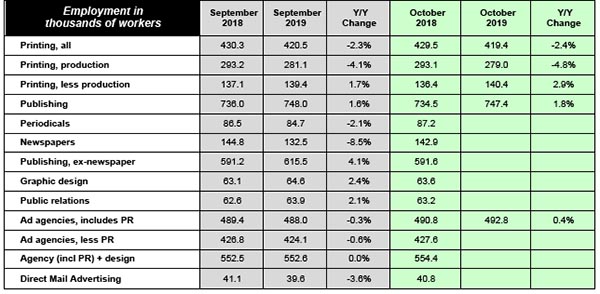
October 2019 employment numbers from the Bureau of Labor Statistics came out last month, and overall printing employment dropped -0.3% from September. On a year-over-year basis, though, it is down -2.4%. We can see where the declines are: production employment was down -0.7% from September to October—and year-over-year was down -4.8%—while non-production employment was up +0.7% from September to October—and year-over-year was up +2.9%. This is not a new story, and the anecdotal tales of the difficulty of hiring production personnel are borne out by the data, here and elsewhere. Hence the emphasis on production automation.
In publishing, employment dropped -0.1% from September to October, but year-over-year grew 1.8%. Newspapers again continued to take a hit employment-wise: down -8.5% from September 2018 to September 2019. Periodicals were not as bad, with a -2.1% decline in employment from September to September.
The creative markets, as is the fashion, are doing better than printing and publishing, although the traditional hotspot, public relations, was only up +2.1% from September 2018 to September 2019. (Back in May, we reported that PR employment had been up +6.7% from March 2018 to March 2019. That level of employment growth in PR has not been repeated since.) Among agencies, employment was down -0.3%, but if we back out PR, agency employment was down -0.6%. Graphic design employment was up +2.4%, and direct mail advertising was down -3.6%.
Overall, the employment situation in the economy has been OK to good. Overall, the US economy gained 128,000 jobs last month and, given that 90,000 new jobs are needed to keep up with population growth, net job growth was a meh 38,000 jobs. Still, the labor force participation rate was up slightly, so there’s that, but the employment-to-population ratio was unchanged. The unemployment rate was up a tad to 3.6%.
Automation may be a solution to the problem of finding elusive employees, but it is also being implemented (in our industry and elsewhere) primarily to reduce costs and improve quality. We probably don’t have to worry about “the robots are taking my job!” (but then, given that productivity has not been exactly off the charts, no one else really does yet either)—the fact is, we may need the robots.









